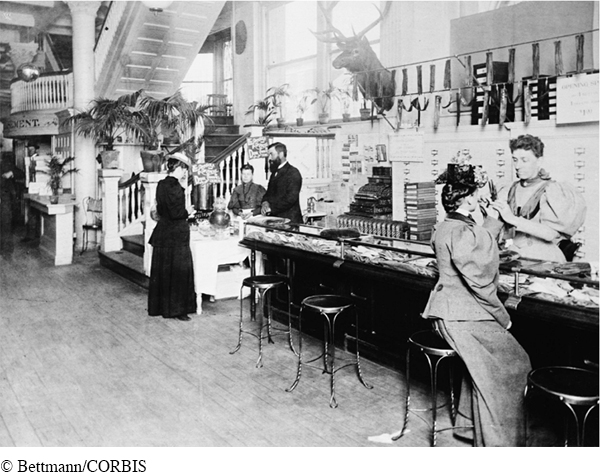Changing Gender Roles
Economic changes led to adjustments in lifestyles and gender roles during the industrial era. Middle-class wives generally remained at home, caring for the house and children, often with the aid of a servant. Whereas in the past farmers and artisans had worked from the home, now most men and women accepted as natural the separation of the workplace and the home caused by industrialization and urbanization. Although the birthrate and marriage rates among the middle class dropped during the late nineteenth century, wives were still expected to care for their husbands and family first to fulfill their feminine duties. Even though daughters increasingly attended colleges reserved for women, their families viewed education as a means of providing refinement rather than a career. One physician summed up the prevailing view that women could only use their brains “but little and in trivial matters” and should concentrate on serving as “the companion or ornamental appendage to man.”
Middle-class women threw themselves into the new consumer culture. Department stores, chain stores, ready-made clothes, and packaged goods, from Jell-O and Kellogg’s Corn Flakes to cake mixes, competed for the money and loyalty of female consumers. Hairdressers, cosmetic companies, and department stores offered a growing and ever-changing assortment of styles. The expanding array of consumer goods did not, however, decrease women’s domestic workload. They had more furniture to dust, fancier meals to prepare, changing fashions to keep up with, higher standards of cleanliness to maintain, and more time to devote to entertaining. Yet the availability of mass-produced goods to assist the housewife in her chores made her role as consumer highly visible, while making her role as worker nearly invisible.

For the more socially and economically independent young women—those who attended college or beauty and secretarial schools—new worlds of leisure opened up. Bicycling, tennis, and croquet became popular sports for women in the late nineteenth century. So, too, did playing basketball, both in colleges and through industrial leagues. Indeed, women’s colleges made sports a requirement, to offset the stress of intellectual life and produce a more well-rounded woman.
Middle-class men enjoyed new leisure pursuits, too. During the late nineteenth century 5.5 million men (of some 19 million adult men in the United States) joined fraternal orders, such as the Odd Fellows, Masons, Knights of Pythias, and Elks. These groups offered middle-class men a network of business contacts and gave them a chance to enjoy a communal, masculine social environment otherwise lacking in their lives.
In fact, historians have referred to a “crisis of masculinity” afflicting a segment of middle- and upper-class men in the late nineteenth and early twentieth centuries. Middle-class occupations whittled away the sense of autonomy that men had experienced in an earlier era when they worked for themselves. The emergence of corporate capitalism had swelled the ranks of the middle class with organization men, who held salaried jobs in managerial departments. At the same time, the push for women’s rights, especially the right to vote, and women’s increasing involvement in civic associations threatened to reduce absolute male control over the public sphere.
Responding to this gender crisis, middle-class men sought ways to exert their masculinity and keep from becoming frail and effeminate. Psychologists like G. Stanley Hall warned that unless men returned to a primitive state of manhood, they risked becoming spiritually paralyzed. To avoid this, went their advice, men should build up their bodies and engage in strenuous activities to improve their physical fitness.
Men turned to sports to cultivate their masculinity. Besides playing baseball and football, they could attend various sporting events. Baseball became the national pastime, and men could root for their home team and establish a community with the thousands of male spectators who filled up newly constructed ballparks. Baseball, a game played by elites in New York City in the 1840s, soon became a commercially popular sport. It spread across the country as baseball clubs in different cities competed with each other. The sport came into its own with the creation of the professional National League in 1876 and the introduction of the World Series in 1903 between the winners of the National League and the American League pennant races.
Boxing also became a popular spectator sport in the late nineteenth century. Bare-knuckle fighting—without the protection of gloves—epitomized the craze to display pure masculinity. A boxing match lasted until one of the fighters was knocked out, leaving both fighters bloody and battered.
During the late nineteenth century, middle-class women and men also had increased opportunities to engage in different forms of sociability and sexuality. Gay men and lesbians could find safe havens in New York City’s Greenwich Village and Chicago’s North Side for their own entertainment. Although treated by medical experts as sexual “inverts” who might be cured by an infusion of “normal” heterosocial contact, gays and lesbians began to emerge from the shadows of Victorian-era sexual constraints around the turn of the twentieth century. “Boston marriages” constituted another form of relationship between women. The term apparently came from Henry James’s book The Bostonians (1886), which described a female couple living together in a monogamous, long-term relationship. This conjugal-style association appealed to financially independent women who did not want to get married. Many of these relationships were sexual, but some were not. In either case, they offered women of a certain class an alternative to traditional, heterosexual marriage.
Exploring American HistoriesPrinted Page 533
Exploring American Histories Value EditionPrinted Page 396
Chapter Timeline